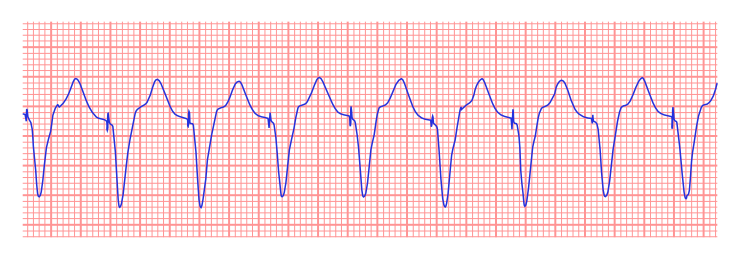Pacemaker mediated tachycardia
Editor-In-Chief: C. Michael Gibson, M.S., M.D. [1]
Synonyms and keywords: PMT, endless loop tachycardia,
Overview
Pacemaker mediated tachycardia is a condition in which an artificial implanted pacemaker stimulates the the ventricles (the lower chambers of the heart) to beat at rates that are inappropriately fast.
Pathophysiology
Pacemaker mediated tachycardia is a form of AV nodal reentrant tachycardia. In PMT, the artificial pacemaker forms the anterograde (atrium to ventricle) limb of the circuit and the atrioventricular (AV) node forms the retrograde limb (ventricle to atrium) of the circuit.
Causes
- The rate response setting of the pacemaker is set too sensitive
- Tracking of noise in the atrium as can occur with electromagnetic interference
- The electrical activity or myopotentials from the chest wall muscles may stimulate the pacer
- The electrocautery device in the operating room may generate electromechanical signals that may be oversensed by the pacemaker
Differential Diagnosis
Disorders from which pacemaker mediated tachycardia must be differentiated include:
- Tracking an atrial tachyarrhythmia by the dual chamber pacemaker
- Runaway pacemaker syndrome in which the pacemaker fires at a rate of nearly 2000 bpm
- Sensor induced tachycardia in which case the pacemaker fires at a rate of nearly 160-180 bpm in response to electrocautery, noise, vibration, limb movement or other stimuli.
Diagnosis
Symptoms
The majority of patients are asymptomatic. Some patients may complain of the following:
Physical Examination
Vital Signs
- A tachycardia at a regular rate of 120 to 130 beats per minute is present
- Hypotension may be present if tachycardia mediated heart failure is present
Neck
- Cannon a waves may be present
Chest
- The pacemaker is present
Electrocardiogram
There is a ventricular-paced rhythm at or near the upper rate limit at approximately 120-130 beats per minute. given the mechanical nature of the trigger, the EKG is absolutely regular.
Shown below is a rhythm strip demonstrating pacemaker mediated tachycardia:

Treatment
The pacemaker can be turned off by placing a magnet over it. The treatment of PMT typically involves reprogramming the pacemaker.